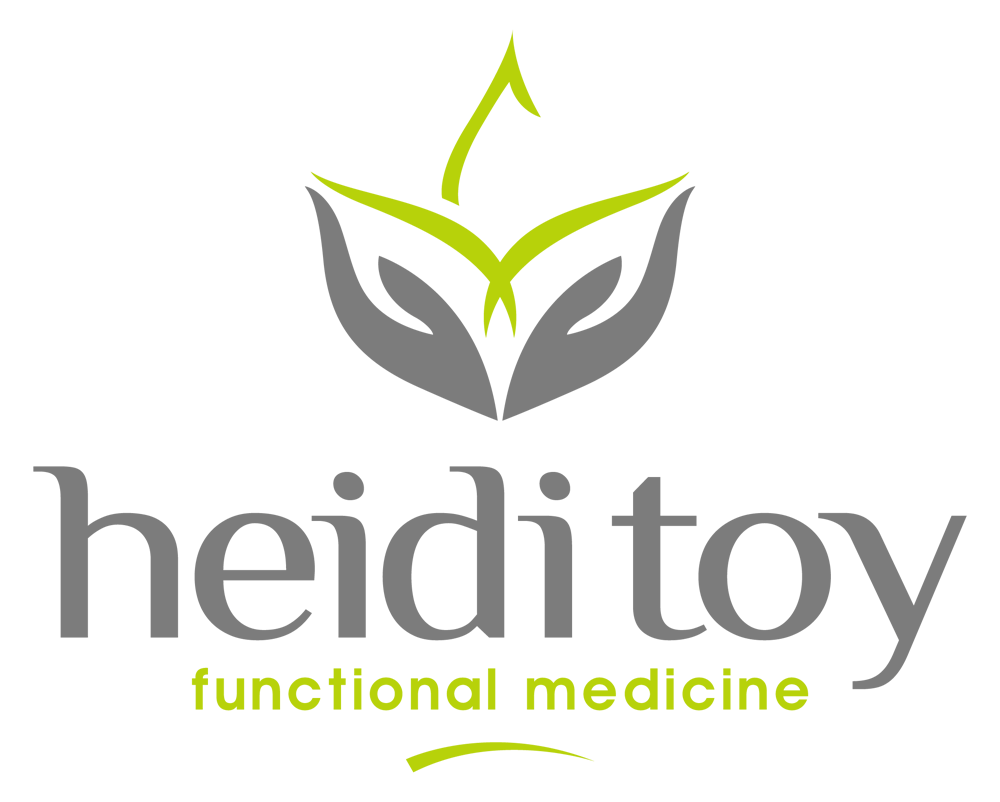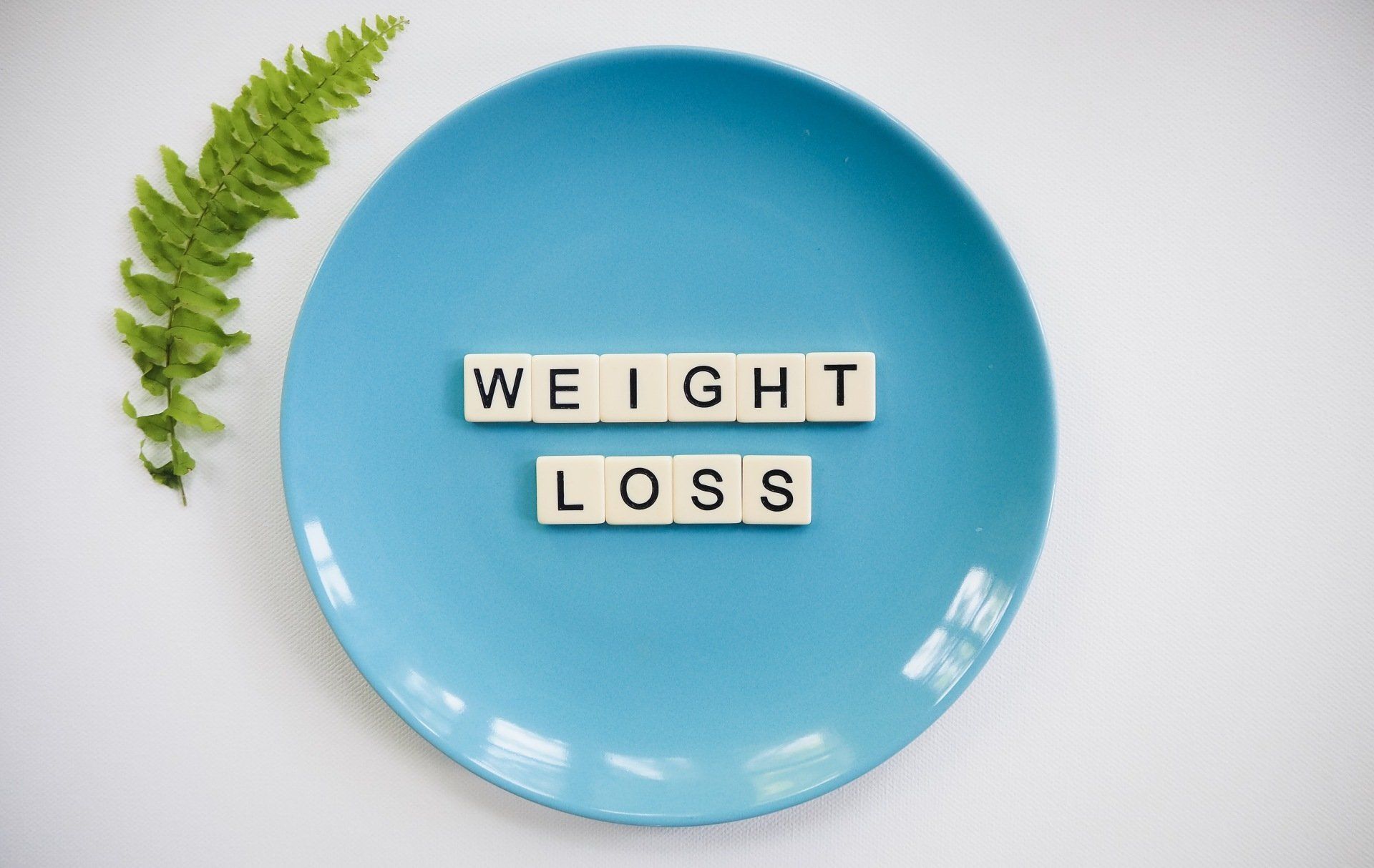Heidi Toy Functional Medicine Blog

Omega-3 and Omega-6 are considered “essential” fatty acids because they cannot be produced by the body--we get them from the food we eat. They are biologically active upon ingestion, which means the body utilizes them right away and cannot store them up for later. They are essential because they help with both inflammatory and anti-inflammatory responses.

One of the reasons fad diets often fail is because they are not sustainable. The other reason is because they usually harm different systems in the body as much as they are meant to help. As with all health issues, when it comes to diet, everything should be in moderation. The following five diet points all involve TOO much of a “good thing”:

When it comes to improving your health and energy levels, the balance between sodium and potassium is crucial. These two minerals are involved in essential cellular functions, working together to maintain your body’s energy, hydration, and response to stress. If you're looking to enhance your mood, energy, and overall well-being, learning about this balance is vital. The Role of Sodium and Potassium in Your Body Inside each of your cells, the sodium-potassium pump helps regulate the movement of nutrients and waste. This process is essential for maintaining energy levels, proper hydration, and managing stress responses. The ratio between sodium and potassium determines how well this pump operates, making it critical for your health. Think of this balance like a tightrope: too much or too little on either side, and things can start to go wrong. Imbalances in sodium and potassium can lead to health problems that may already be affecting how you feel on a daily basis. Ideal Sodium-Potassium Ratio for Health In Hair Tissue Mineral Analysis (HTMA), the optimal sodium-to-potassium ratio typically falls between 2.1 and 3.1, with 2.4 being the median. This ratio reflects how well your body manages stress, inflammation, and hydration. When your sodium-potassium balance is off, it can be a sign of deeper issues with stress and overall health. High Sodium-Potassium Ratio: A Signal of Acute Stress A sodium-potassium ratio above 3.1 suggests that your body may be dealing with acute stress or inflammation. Some common signs of an elevated ratio include: Water Retention and Bloating: High sodium levels can cause the body to retain water, leading to puffiness or swelling. High Blood Pressure: Increased sodium often results in elevated blood pressure, especially if excess water is being held in your system. Mood Swings and Irritability: Rapid changes in mood, heightened stress responses, and irritability can be tied to high sodium levels. Hormonal Imbalances: An imbalance in sodium and potassium can lead to estrogen dominance, affecting other hormones and potentially causing mood swings, bloating, and menstrual irregularities. Liver and Kidney Strain: If your ratio is excessively high—above 12—it can indicate significant stress on your liver and kidneys, two organs essential for detoxification. Factors such as exposure to heavy metals (like copper, mercury, or aluminum) or certain medications can also elevate your sodium levels, pushing this ratio higher. Low Sodium-Potassium Ratio: A Marker of Chronic Fatigue If your sodium-to-potassium ratio falls below 2.1, it’s often a sign of chronic fatigue or prolonged stress. A low ratio, also known as an "inverted ratio," is associated with several symptoms: Chronic Fatigue and Weak Immunity: A low ratio indicates that your body is exhausted, often resulting in feelings of extreme fatigue and a weakened immune system. Food Cravings and Digestive Issues: Low potassium levels can trigger cravings for sugar or stimulants, and may lead to digestive discomfort. Emotional Instability: Low potassium can also contribute to irritability, frustration, and feelings of being emotionally drained. Trauma Response: When the sodium-potassium ratio dips below 1, it can be linked to deep-seated stress or trauma, signaling that your body needs serious support. As with a high ratio, heavy metal toxicity or certain medical treatments can contribute to a lowered sodium-potassium ratio, making it essential to address both mineral imbalances and environmental factors. How to Restore Sodium-Potassium Balance Bringing your sodium-potassium ratio back into balance is key to improving energy and overall health. Here's what you can do: For a High Ratio: Increase Potassium-Rich Foods: Eat more potassium-rich foods like bananas, avocados, leafy greens, and sweet potatoes to help counteract high sodium levels. Reduce Inflammation: Investigate possible sources of chronic inflammation, whether it's diet-related, stress-related, or due to exposure to toxins. Lower Stress: Engage in stress management techniques such as mindfulness, meditation, or gentle exercise to help reduce inflammation and restore balance. For a Low Ratio: Consider Potassium Supplements: If HTMA results show low potassium, supplementation may be necessary to correct the imbalance. Support Emotional Health: Chronic stress or trauma can often be at the root of low ratios. Seeking emotional support through therapy or stress-reducing activities can help. Check for Toxic Metals: If heavy metals are present, detoxifying your body may be required to restore proper sodium-potassium balance. Conclusion: Balance is Key to Wellness The sodium-potassium ratio may seem like a small detail, but it has a major impact on your health and energy levels. Whether you’re struggling with chronic fatigue, mood swings, or inflammation, maintaining the right sodium-potassium balance is crucial for overall vitality. Paying attention to this balance can help you manage stress, support your hydration, and guide you toward better health. By incorporating strategies to restore your sodium-potassium ratio, you can take control of your well-being and experience more energy, better mood stability, and improved resilience against stress. HTMA is the way to understand your own ratio. In a few days, the 'Special of the Year' will be revealed, allowing you to discover your personal ratio and learn how to enhance it, along with your health and energy! Make sure to sign up for my newsletter and open your emails!

It’s a safe bet that many people today are dealing with sluggish livers, even if they don't realize it. With the constant exposure to toxins in our modern environment, the liver, our body’s primary detox organ, is working overtime to clear out the “junk” we encounter every day. Whether it’s heavy metals, chemical pollutants, mold, or even stress, your liver is under constant pressure to keep up. While it’s easy to assume that most of us have some level of liver dysfunction, it’s important to understand how serious the situation is for each individual. A sluggish liver can lead to a variety of health issues, but it’s not always easy to pinpoint without the right testing. That’s where a Hair Tissue Mineral Analysis (HTMA) comes in, offering valuable insights into liver function and overall health. Here’s how an HTMA can help assess liver health and why you should consider this test for yourself or your family. 1. Cobalt Levels: A Clue to Liver Health One of the best indicators of liver performance that shows up on an HTMA panel is cobalt. Cobalt is a mineral that has two sides: as part of Vitamin B12 (methylcobalamin or hydroxocobalamin), and as a toxic metal in high amounts. When the liver isn’t functioning properly, the body can’t absorb Vitamin B12 efficiently, leading to cobalt accumulation in the liver. This build-up can manifest in various health issues, including thyroid problems, tinnitus, blood thickening, and even vision or hearing loss. Elevated cobalt levels in the hair can be a red flag that the liver is under stress. By paying attention to cobalt levels in an HTMA, you can get a clearer picture of your liver’s ability to detoxify and absorb essential nutrients. 2. The Sodium/Potassium Ratio: A Life-Death Indicator Another vital aspect of liver health reflected in HTMA results is the sodium to potassium (Na/K) ratio. Sometimes referred to as the “Life-Death” ratio, this measurement reveals a lot about your body's overall stress and energy levels. A low Na/K ratio typically indicates burnout, chronic fatigue, low stomach acid, and compromised immune function. All of these issues are connected to liver dysfunction. The body’s inability to detoxify and heal is often a result of chronic stress and infections, which can further impair liver function. If you have infections, the liver may be struggling to keep up with the detox demands, making the Na/K ratio a valuable marker for assessing overall liver health. 3. Heavy Metal Levels: A Key Sign of Liver Strain Heavy metals like mercury, lead, arsenic, cadmium, and aluminum are highly toxic to the body. When these metals show up in an HTMA panel, it’s a clear indication that the liver is working hard to detoxify the system. Interestingly, low levels of heavy metals can also signal liver trouble. If your HTMA shows little to no heavy metal excretion, it could mean the body is storing these toxins rather than eliminating them. This often points to an overburdened or sluggish liver that isn’t able to keep up with the detoxification demands. Either way, the presence (or absence) of heavy metals is an important clue that your liver might be overwhelmed, making it crucial to support proper detoxification pathways. 4. Oxidation Rate: Slow Metabolism, Slow Detox HTMA also helps assess the body’s metabolic rate through the oxidation rate, which is the balance between calcium and phosphorus. When this ratio is elevated, it indicates slow oxidation, meaning a slower metabolism. People with slow oxidation rates tend to be poor eliminators, meaning they struggle to detoxify and remove toxins from the body. This is another key indicator that the liver is sluggish and not able to efficiently process toxins. When your metabolism slows down, so does your liver’s ability to clear out harmful substances, leaving you feeling fatigued, bloated, and overwhelmed. 5. Lithium Levels: A Detoxification Powerhouse Lithium is a fascinating and often overlooked mineral when it comes to liver health. While most commonly known for its pharmaceutical use in treating bipolar disorder, lithium also plays an important role in detoxification. On an HTMA panel, low lithium levels can indicate poor detoxification, particularly in terms of glutathione production. Glutathione is the body’s master antioxidant, essential for detoxifying the liver and protecting cells from oxidative damage. If lithium is low, it may suggest that your liver is struggling to produce enough glutathione to keep up with detox demands. Although research on lithium’s role in detoxification is still emerging, clinical evidence points to its importance in supporting healthy liver function. The Bottom Line: Start with Minerals for Better Detoxification The liver is central to your body’s ability to detoxify, but it can’t do the job alone. Minerals are the foundation of every detox pathway in the body. Without adequate mineral support, detoxification can’t happen effectively, no matter how many supplements or herbs you take. This is why it’s so important to use HTMA testing to assess mineral levels and create a plan to restore balance. When you support the body with the right minerals, you can improve liver function, increase detoxification, and enhance overall health. Why Wait? Something Big is Coming! If you’re ready to get serious about your liver health and understand your body’s detox capabilities, there’s no better way to start than with an HTMA test. This test provides critical insights into your mineral balance, liver health, and overall metabolic function. And the best part? A major deal is coming your way this Thanksgiving! Keep an eye on your emails because you won’t want to miss out on what’s coming—a huge opportunity to get the testing and insights you need to take control of your health. Make sure you’re ready for this game-changing offer—it’s going to be the deal of the year!

If you have followed our discussions over the past several weeks, you now understand that minerals are indispensable for maintaining overall health. What may be less known is their critical role in preserving the integrity and function of the digestive system. Our gut relies heavily on the proper balance of minerals to maintain digestion, nutrient absorption, and immunity. When mineral balance is disrupted, it can lead to a cascade of digestive problems and gut imbalances that perpetuate a cycle of poor health. To support optimal gut function and overall wellness, understanding the roles that key minerals like calcium, magnesium, selenium, zinc, and electrolytes play is essential. Calcium: Enhancing Digestive Function with Hydrochloric Acid One of the most critical functions of calcium in the digestive system is its role in enhancing the production of hydrochloric acid (HCl) in the stomach. HCl is essential for breaking down food, particularly proteins, and it helps to sterilize the stomach by killing harmful pathogens before they reach the intestines. Without sufficient HCl, digestion can be compromised, leading to indigestion, bloating, and malabsorption of nutrients. Beyond digestion, calcium’s influence on hydrochloric acid production also helps improve intestinal permeability, often referred to as "leaky gut." Leaky gut occurs when the tight junctions of the intestinal lining weaken, allowing undigested particles and toxins to enter the bloodstream, triggering inflammation. By enhancing HCl production, calcium can help tighten these junctions and reduce permeability. Additionally, calcium plays a key role in easing diarrhea by helping to regulate fluid balance in the intestines. Chronic diarrhea can result in a significant loss of essential minerals, creating a vicious cycle of malabsorption and further mineral deficiencies. By supporting gut integrity and fluid balance, calcium helps break this cycle, making it a critical mineral for gut health. Magnesium: Balancing Calcium and Supporting Bowel Regularity Magnesium works in harmony with calcium to balance its stimulatory effects on hydrochloric acid production. Where calcium promotes HCl production, magnesium ensures that this process doesn't become overstimulated, which could lead to excessive acid levels and related discomforts. Magnesium also plays a key role in promoting regular bowel movements and easing constipation. It helps to relax the muscles in the digestive tract, allowing for smoother movement of stool through the intestines. This mineral also supports gallbladder function by ensuring that bile is properly emptied, which aids in fat digestion and overall gut health. In cases of constipation, magnesium can offer relief by drawing water into the intestines, which helps soften stool and promote regularity. Proper magnesium levels are vital for preventing digestive sluggishness and maintaining optimal motility throughout the digestive system. Selenium: A Protector of the Gut and Pancreas Selenium is often praised for its powerful antioxidant properties, but it is also crucial for gut and pancreatic health. Selenium helps to reduce inflammation in the digestive system by supporting the production of selenoproteins, which are anti-inflammatory in nature. These proteins play a key role in protecting the gut lining from oxidative stress and inflammatory damage, both of which can contribute to conditions like leaky gut and irritable bowel syndrome (IBS). Furthermore, selenium supports pancreatic health by promoting the production of digestive enzymes. These enzymes are necessary for the breakdown of food and nutrient absorption. Without adequate selenium, pancreatic function can become impaired, leading to issues with digestion and nutrient malabsorption. In addition to its role in the pancreas, selenium helps to promote a healthy gut microbiome by reducing oxidative stress, which allows beneficial bacteria to thrive. A balanced microbiome is essential for optimal digestion, immune function, and even mental health, making selenium a vital mineral for overall gut wellness. Zinc: Essential for Gut Lining Integrity and Immune Support Zinc plays a critical role in promoting the production of pancreatic enzymes, which are essential for the proper digestion of proteins, fats, and carbohydrates. Without adequate levels of these enzymes, food cannot be broken down efficiently, leading to malabsorption and digestive discomfort. Zinc is also crucial for maintaining the integrity of the gut lining. It supports the tight junctions between cells in the intestinal wall, preventing leaky gut and the associated inflammatory responses. By ensuring a healthy gut barrier, zinc reduces the risk of systemic inflammation and the development of autoimmune conditions. In the gut, zinc also helps to regulate immune cells and decrease inflammation. It protects against oxidative damage caused by excess iron and copper, which can otherwise trigger inflammation. Furthermore, zinc promotes microbiome diversity, which is key to a healthy and resilient gut. Zinc also helps ease diarrhea by reducing intestinal inflammation and promoting fluid balance, making it an essential mineral for gut health. Electrolytes: Hydration and Digestive Regularity Electrolytes—namely sodium, chloride, and potassium—are essential for maintaining proper hydration and fluid balance in the body. These minerals help to regulate bowel motility and ensure that waste moves smoothly through the digestive tract. Proper electrolyte balance supports regular bowel movements and prevents both constipation and diarrhea by maintaining the correct levels of fluid in the intestines. The Vicious Cycle: Mineral Deficiencies and Gut Health When inflammation or imbalance occurs in the gut, it often leads to the malabsorption of minerals and vitamins, which can exacerbate gut dysfunction. Over time, this creates a vicious cycle where poor gut health leads to further mineral deficiencies, which in turn worsens digestive problems. Breaking this cycle requires a two-pronged approach: supporting both mineral balance and digestion. This is why I almost always recommend Hair Tissue Mineral Analysis (HTMA) in conjunction with other functional medicine testing to assess and address mineral imbalances. Conclusion Maintaining a balanced intake of essential minerals is crucial for supporting gut health. Calcium, magnesium, selenium, zinc, and electrolytes each play unique roles in digestion, absorption, and gut integrity. Without these key minerals, digestive health suffers, leading to a cascade of health problems. To break the cycle of malabsorption and gut dysfunction, it’s essential to address both mineral balance and digestive function simultaneously. Sign up for my newsletter to stay informed about exciting new ways to support your gut health and keep an eye out for something big coming this holiday season! You won't want to miss it!

Bone health hinges on a delicate balance between two key types of cells: osteoblasts, which are responsible for bone formation, and osteoclasts, which break down bone tissue. This intricate process is influenced by various factors, including nutrient levels, hormones like estrogen and vitamin D, age, inflammation, and the beneficial stress from exercise. For women over the age of 50, the risk of decreased bone density can lead to conditions such as osteoporosis and osteoarthritis. These issues significantly raise the risk of falls and fractures. It’s worth noting that gluten intolerance can contribute to underlying inflammation, further complicating bone health. Essential Nutrients for Bone Strength To support robust bone health, it’s vital to incorporate a variety of essential nutrients into your diet: Calcium: A critical component of bone density, found in dairy products (preferably fermented), tofu, sardines, and dark leafy greens. Protein: Necessary for bone structure and repair, sources include meat, fish, seafood, eggs, beans, legumes, dairy, bone broth, and collagen powder. Vitamin D: Important for calcium absorption and bone mineralization, it can be obtained from sunlight exposure, fish, liver, and eggs. Vitamin K: Plays a significant role in bone metabolism, available in green vegetables, eggs, and kiwi. Magnesium: Supports overall bone strength and can be found in nuts, seeds, legumes, and leafy greens. Silicon: Contributes to bone density and can be sourced from whole grains, carrots, green beans, and even beer. Boron: Aids calcium absorption, with sources including prunes, raisins, dried apricots, and avocados. Additionally, bone metabolism is influenced by other nutrients such as vitamin C, B vitamins, potassium, fluoride, phosphorus, manganese, iron, zinc, and copper. The Whole-Food Approach: Why Diet Matters It’s essential to understand that no supplement can substitute for the diverse nutrition that a balanced, whole-food diet provides. Along with sufficient nutrient intake, engaging in weight-bearing exercises is crucial for promoting bone density, muscle strength, and balance. Enhancing Bone Health with Prebiotics and Probiotics Integrating prebiotics and probiotics into your meals can enhance calcium absorption in the digestive system, providing further support for your bone health. Sunlight: Your Natural Source of Vitamin D The best way to elevate your vitamin D levels , a key regulator of bone mineralization, is through sunlight exposure. Navigating the Complex World of Supplements While the use of supplements can be a complex topic, it’s important to focus on a varied diet. Consider vitamin D3 and K2 supplementation only if testing reveals deficiencies, as the factors affecting bone density are multifaceted. Insightful Analysis Through HTMA Testing For a comprehensive understanding of your nutritional status, consider an HTMA (Hair Tissue Mineral Analysis). This insightful test reveals your levels of essential minerals as well as the ratios between them, providing a clearer picture of your overall mineral balance. By analyzing your unique mineral profile through HTMA, you can pinpoint any deficiencies or excesses that may affect your bone health. Conclusion: Laying the Groundwork for Strong Bones In summary, achieving bone balance involves a multi-dimensional strategy that includes a variety of nutrients, regular physical activity, and awareness of health conditions that can impact bone density. By prioritizing a nutrient-rich diet and employing tools like HTMA testing , you can take proactive steps to enhance your bone health and reduce the risk of fractures and falls as you age. In my private sessions and group program, EnergyRx , I teach clients how to apply these principles to support not only their bone health but overall energy and well-being. By understanding the role of minerals and running HTMA testing, you can take control of your health and implement personalized strategies to balance your body from the inside out. Join me to learn how to unlock better energy and stronger bones through nutrition, exercise, and mineral balance. Ready to transform your health? Sign up today! And always, stay engaged and informed about your bone health—it’s never too late to strengthen your foundation!

The thyroid is a small, butterfly-shaped gland located at the base of your neck, playing a critical role in regulating your body’s metabolism. Think of it as the thermostat of your body—it helps control how fast or slow your cells function. When your metabolism is too low, your brain initiates a hormonal response to "turn up the heat." When your metabolism is too high, thyroid hormones are deactivated to prevent overstimulation of the body. The thyroid doesn’t operate in isolation. It communicates closely with your brain through a system called the Hypothalamic-Pituitary-Thyroid (HPT) axis. This network sends signals between the brain and the thyroid to maintain a balanced metabolism. When this system is working correctly, the thyroid helps keep your body’s processes—such as energy production, heart rate, and body temperature—in check. What Is Hypo- and Hyperthyroidism? A properly functioning thyroid responds effectively to changes in the body’s energy demands. But what happens when the thyroid becomes compromised? If the thyroid is impaired—due to stress, toxins, autoimmune damage, nutrient deficiencies, or other factors—every system in the body can be affected. There are two main types of thyroid dysfunction: hypothyroidism and hyperthyroidism. Hypothyroidism occurs when the thyroid doesn’t produce enough hormones, slowing down the metabolism. This can lead to symptoms like weight gain, fatigue, depression, and cold intolerance. Hyperthyroidism occurs when the thyroid produces too many hormones, speeding up the metabolism. Symptoms include rapid weight loss, nervousness, excessive sweating, and heart palpitations. Autoimmune diseases can also affect thyroid function. Hashimoto's thyroiditis often leads to hypothyroidism, while Graves' disease is a common cause of hyperthyroidism. Thyroid Markers: A Detailed Look A complete thyroid panel provides a more in-depth view of thyroid function beyond standard blood tests. Here are key markers to consider: 1. Thyroid Releasing Hormone (TRH): Produced by the hypothalamus in the brain, TRH signals the pituitary gland to release Thyroid Stimulating Hormone (TSH). If TRH is off, the entire thyroid hormone cascade may be disrupted. 2. Thyroid Stimulating Hormone (TSH): The standard marker in blood tests to assess thyroid function. High TSH suggests the thyroid isn’t responding to signals and needs more stimulation to produce hormones, while low TSH may indicate an overactive thyroid. 3. Total T4 and Total T3: These represent the total circulating thyroid hormones. T4 is the inactive form that the body converts into T3, the active form. These markers provide an overview of thyroid function. 4. Free T4 and Free T3: These measure the unbound hormones in the bloodstream that can signal the body’s cells. While total T4 and T3 indicate how much hormone is in the blood, the "free" levels show how much is available for use. 5. Thyroid Binding Globulin (TBG): This protein binds to thyroid hormones in the blood. Too much TBG can prevent free T4 and T3 from effectively signaling cells. 6. Thyroid Antibodies: Markers such as TPO, TG, and TSHR antibodies can identify autoimmune activity against the thyroid. Elevated antibodies often indicate the body is attacking the thyroid, sometimes before symptoms are apparent. Beyond Blood Tests: The Calcium-Potassium (Ca/K) Ratio While blood tests offer valuable insights, they don’t always tell the full story. This brings us to the calcium-potassium (Ca/K) ratio, a marker found in a Hair Tissue Mineral Analysis (HTMA) panel that acts as a "dashboard" for thyroid activity. The ideal ratio is 4.2. When this ratio is off, it may suggest thyroid dysfunction—either underactive or overactive. Calcium is regulated by thyroid hormones via calcitonin. When calcium levels are high, it often indicates the thyroid is underactive, leading to hypothyroid symptoms like weight gain, fatigue, and constipation. Potassium plays a crucial role in how tissues respond to thyroid hormones. Low potassium levels can prevent normal thyroid hormone levels from entering cells effectively, causing symptoms of hypothyroidism, even if lab results appear normal. High Ca/K Ratio: Signs of Cellular Hypothyroidism An elevated Ca/K ratio indicates a sluggish thyroid. Symptoms might include: Weight gain Fatigue Dry skin Constipation This imbalance suggests that potassium may be needed to support thyroid hormone activity. Copper toxicity may also contribute to thyroid dysfunction, especially if the Ca/K ratio climbs above 10, where copper toxicity becomes a more significant factor. Low Ca/K Ratio: Signs of Cellular Hyperthyroidism A low Ca/K ratio can signal hyperthyroidism, where the thyroid is overactive. Symptoms include: Excessive sweating Hyperactivity Anxiety Nervousness It's important to recognize that this is a cellular process because it occurs at the cellular level. Some clients present these symptoms, and despite their doctors conducting thyroid tests through blood chemistry, the results often return normal. These clients leave feeling frustrated and still symptomatic. However, when we conduct hair tissue mineral testing, we often uncover significant findings. Be cautious with calcium supplementation if you have a low Ca/K ratio, as too much calcium can slow down metabolism and worsen thyroid dysfunction symptoms. It is important to work with a practitioner skilled in HTMA. The HPA Axis and Its Impact on Thyroid Function Thyroid health is closely linked to the Hypothalamic-Pituitary-Adrenal (HPA) axis, which regulates the body’s response to stress by releasing cortisol, the "stress hormone." A healthy HPA axis manages stress effectively, but chronic stress can lead to HPA dysfunction, sometimes referred to as “adrenal fatigue.” When the body is under long-term stress, cortisol can interfere with the conversion of T4 (inactive thyroid hormone) into T3 (active thyroid hormone), exacerbating hypothyroid symptoms. Hair Tissue Mineral Analysis (HTMA) assesses stress by evaluating mineral levels and ratios that are directly influenced by the body's response to stress. Chronic stress alters the balance of essential minerals, which HTMA can detect. Conclusion: A Complete View of Thyroid Health Understanding thyroid health requires more than just blood work. While blood tests provide a snapshot of hormone levels in circulation, they don’t always show how well those hormones are used by the body’s cells. That’s where tools like the calcium-potassium (Ca/K) ratio from an HTMA come in. This ratio can offer additional insights beyond traditional blood tests. Whether you’re experiencing hypothyroidism or hyperthyroidism, considering both blood work and HTMA results will give you a fuller picture of what’s happening with your thyroid. Don’t miss out on what’s coming next! If you’re serious about understanding your thyroid health and unlocking your body’s mineral balance, keep an eye on your inbox! Something huge is coming around Thanksgiving, and you won’t want to miss it—sign up for my newsletter to stay informed. Your thyroid health could be about to take a major turn for the better! References Thyroid Disease. Cleveland Clinic. https://my.clevelandclinic.org/health/diseases/8541-thyroid-disease Jones, D. S., Bland, J. S., & Quinn, S. (2010). Textbook of Functional Medicine. Institute for Functional Medicine. Gaby, A. R. (2017). Nutritional Medicine (2nd ed.). Fritz Perlberg Publishing. Magnesium and Thyroid Health. Retrieved from: https://thyroidpharmacist.com/articles/new-studies-on-magnesium-and-thyroid-health/

Female hormones play a vital role in overall health and wellbeing, influencing everything from mood and energy to reproductive health and metabolism. Imbalances in hormones like estrogen, progesterone, and cortisol can lead to various health issues, including mood swings, fatigue, weight gain, and more. Hair Tissue Mineral Analysis (HTMA) offers valuable insight into how mineral levels and ratios in the body are connected to hormonal health. In this post, we’ll explore how HTMA can provide a window into female hormonal balance by analyzing specific mineral ratios and their relation to key hormones. 1. Sodium to Potassium (Na/K) Ratio: The Vitality Ratio The sodium to potassium (Na/K) ratio is often referred to as the “vitality ratio” because it plays a central role in overall health and energy levels. This ratio is a critical marker of adrenal function, which is closely linked to the production of hormones like cortisol and aldosterone. Cortisol is a stress hormone that, when imbalanced, can wreak havoc on female hormones, particularly estrogen and progesterone. High Na/K Ratio: A high Na/K ratio suggests elevated adrenal activity, often due to chronic stress or inflammation. This can lead to an overproduction of cortisol, which, in turn, may suppress progesterone levels and contribute to estrogen dominance. Symptoms of estrogen dominance include weight gain, mood swings, irregular periods, and PMS. Low Na/K Ratio: A low Na/K ratio, on the other hand, indicates adrenal burnout or exhaustion. When cortisol levels are depleted due to prolonged stress, it can lead to low progesterone, irregular menstrual cycles, and a higher risk of infertility. This imbalance may also cause fatigue, sugar cravings, and a weakened immune system. In summary, the Na/K ratio reflects the balance between cortisol and other female hormones. Keeping this ratio in a healthy range is essential for maintaining hormonal balance and preventing estrogen dominance or progesterone deficiency. 2. Calcium to Potassium (Ca/K) Ratio: The Thyroid and Estrogen Connection The calcium to potassium (Ca/K) ratio is often referred to as the “thyroid ratio,” as it reflects thyroid activity. The thyroid plays a crucial role in regulating metabolism and energy levels, but it also influences female hormones, particularly estrogen. An imbalance in thyroid function can lead to a domino effect on hormones, including estrogen and progesterone. High Ca/K Ratio: A high Ca/K ratio is indicative of sluggish thyroid function, also known as hypothyroidism. This condition can lead to higher estrogen levels because the thyroid helps regulate estrogen metabolism. Hypothyroidism can also contribute to symptoms like weight gain, depression, and heavy or irregular periods, which are often linked to estrogen imbalances. Low Ca/K Ratio: A low Ca/K ratio, on the other hand, suggests an overactive thyroid, or hyperthyroidism. This condition can cause lower estrogen levels, leading to symptoms such as light or absent periods, anxiety, and increased heart rate. Hyperthyroidism can also affect fertility by disrupting the delicate balance of estrogen and progesterone. In women, maintaining a balanced Ca/K ratio is crucial for proper thyroid function, which directly impacts estrogen metabolism and overall hormonal health. 3. Calcium to Magnesium (Ca/Mg) Ratio: The Stress and Progesterone Balance The calcium to magnesium (Ca/Mg) ratio is often called the “stress ratio,” as it reflects the body’s ability to handle stress. This ratio is particularly important for balancing the effects of estrogen and progesterone, two key female hormones that are sensitive to stress levels. High Ca/Mg Ratio: A high Ca/Mg ratio suggests that the body is under stress, which can elevate cortisol levels and disrupt progesterone production. Low progesterone levels can lead to symptoms like irregular periods, PMS, anxiety, and even infertility. High stress levels can also contribute to estrogen dominance, worsening symptoms like bloating, mood swings, and fatigue. Low Ca/Mg Ratio: A low Ca/Mg ratio indicates that magnesium levels are higher in relation to calcium. Magnesium is essential for relaxing the nervous system and supporting the production of progesterone. Women with low progesterone levels may benefit from increasing their magnesium intake to support hormonal balance. The Ca/Mg ratio is a key indicator of how well a woman’s body is managing stress and, in turn, how well her progesterone and estrogen levels are balanced. 4. Zinc to Copper (Zn/Cu) Ratio: The Hormonal Regulator The zinc copper (Zn/Cu) ratio is another important marker in HTMA, as it reflects the balance between two minerals that are crucial for hormonal regulation. Zinc supports the production of progesterone, while copper is closely linked to estrogen metabolism. High Zn/Cu Ratio: A high Zn/Cu ratio indicates higher levels of zinc relative to copper, which can support progesterone production and help prevent estrogen dominance. Women with symptoms of low progesterone, such as irregular periods or PMS, may benefit from optimizing their zinc levels. Low Zn/Cu Ratio: A low Zn/Cu ratio, on the other hand, suggests higher levels of copper relative to zinc. This imbalance is often associated with estrogen dominance, as copper is linked to increased estrogen activity. Symptoms of estrogen dominance, such as bloating, breast tenderness, and mood swings, are more likely to occur when the Zn/Cu ratio is out of balance. Maintaining a healthy Zn/Cu ratio is essential for regulating the balance between estrogen and progesterone, ensuring proper reproductive health and hormonal harmony. 5. Phosphorus Levels and Hormonal Health Phosphorus, though not part of a specific ratio, plays a crucial role in energy metabolism and hormone production. Low phosphorus levels can be an indicator of poor energy production and may reflect a state of hormonal burnout. Women experiencing chronic fatigue, irregular cycles, or hormonal imbalances may benefit from assessing their phosphorus levels through HTMA. Conclusion: HTMA as a Tool for Female Hormonal Balance Hair Tissue Mineral Analysis (HTMA) is a powerful tool for understanding the intricate relationship between minerals and female hormones. By analyzing key mineral ratios—such as sodium to potassium, calcium to potassium, calcium to magnesium, and zinc to copper—HTMA provides valuable insights into how the body’s mineral balance affects hormone production, stress management, and overall health. Balancing these mineral ratios can help address common hormonal imbalances, such as estrogen dominance, low progesterone, thyroid dysfunction, and adrenal fatigue. For women looking to optimize their hormonal health, HTMA offers a personalized approach to achieving balance and wellbeing. To truly understand your body’s zinc levels and how they fit into your mineral landscape, I highly recommend getting an HTMA test. And here’s the exciting part — something special is on the horizon for the holidays, so make sure you’re signed up for my newsletter and keeping an eye on your inbox. You won’t want to miss it!
























































































